By Dr. Tabitha Mallory and Dr. Ian Ralby
A flurry of news stories in late July 2020 reported on the “discovery” of a “massive” fleet of Chinese fishing vessels in the waters off the Galapagos, which fluctuated to over 350 before the fleet finally left by mid-October to fish farther south. Yet the presence of the Chinese distant water fishing fleet in the area has been expanding for several years. Concerns over the fleet’s illegal, unreported, and unregulated (IUU) fishing have also grown, spurred by the August 2017 arrest of the FU YUAN YU LENG 999, a Chinese-flagged refrigerated vessel found in the Galapagos with roughly 300 tons of rare, near extinct or endangered species onboard, including 600 sharks.
Using data and insight from Windward, a predictive maritime intelligence platform, our analysis examines how this fishing phenomenon has evolved over time and who is behind this increasingly intensive fishing effort. We argue that this fishing activity is the outcome of China’s global fisheries strategy, including the generous subsidies provided to the industry. We examine the extent to which China may be engaging in IUU fishing, arguing that although the Chinese government has moved to curtail IUU fishing activities, several challenges remain. While the fleet appears to largely be operating legally, some behavior indicates exceptions. Furthermore, despite any seemingly technical compliance with existing laws and regulations, some of Chinese fishing activity falls into the “unreported” and “unregulated” categories and deserves careful consideration in terms of the sustainability of such operations.
New Attention, but Not New
Windward data helps to visualize the Chinese fleet’s activity over time, illustrating that the presence of Chinese fishing vessels in the waters around the Galapagos 200-nautical mile exclusive economic zone (EEZ) has been increasing for several years. In 2015, there was virtually no Chinese fishing activity in the Galapagos and the waters outside the archipelago’s EEZ. Beginning in 2016, however, that changed dramatically. In August 2016, for example, 191 different Chinese-flagged vessels engaged in fishing operations in the wider Galapagos area—a stark contrast to the one Chinese vessel that was detected in that area the same month in 2015. The numbers have only increased since then, fluctuating with the fishing seasons. Over the course of 2017, three months saw more than 200 vessels fishing in the area, peaking at 263 in the month of July. In 2018, there were four consecutive months—May through August—with over 200 Chinese vessels fishing in the area, and a fifth month, December, with 193. The peak that year was 286 in June. In 2019, there were five months with over 200 vessels, and two more, June and July, with 197 and 130, respectively. The peak in 2019 was September, with 298.
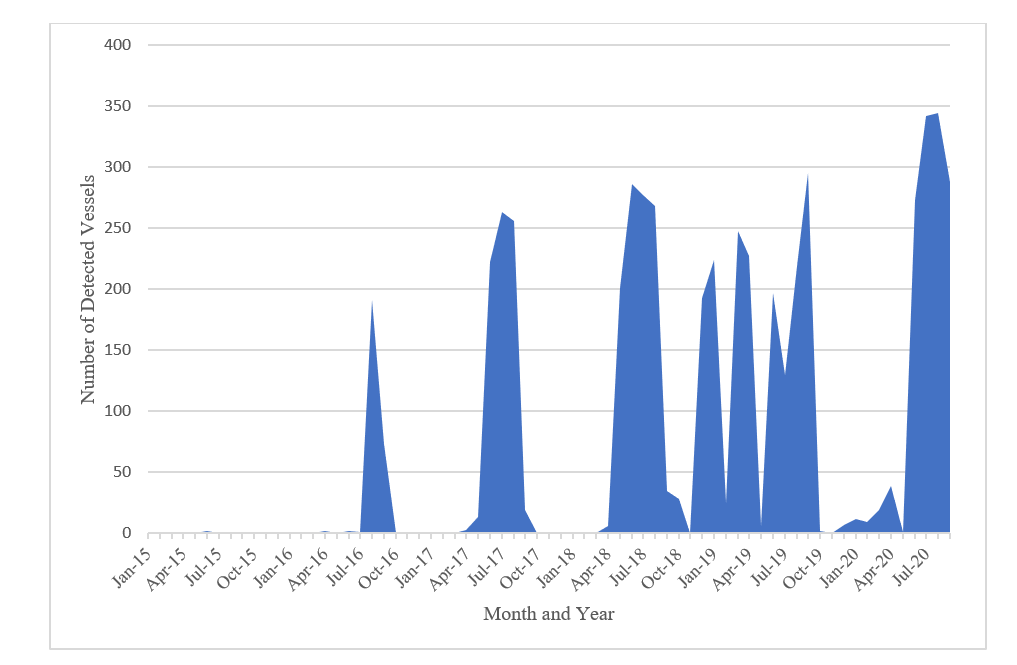
To better understand what is behind this huge increase in activity, it is important to understand the policies that are driving the Chinese fishing industry.
Understanding China’s Global Fishing Strategy
Thanks to the data aggregation capabilities of Windward, it is possible to examine some of the details behind this massive fleet. Between July and August 2020, 364 different Chinese vessels in the area transmitted on automated information system (AIS). All vessels over 300 gross tons operating internationally must, under the Safety of Life at Sea (SOLAS) Convention, be fitted with AIS and keep it turned on. Therefore, there may have been more than 364 vessels, as some may have been present but “dark” and thus undetectable through AIS. Examining just those 364, however, reveals valuable insights into the ownership behind them and their provinces of origin. Notwithstanding a few vessels whose ownership is unknown, 55 companies own the fleet on paper, though several companies have identical addresses, indicating that there may be fewer than 55 beneficial owners.
The vessels off the Galapagos are part of China’s distant water fishing (DWF) fleet, which operates in areas beyond national jurisdiction—or the “high seas” as defined under the United Nations Convention on the Law of the Sea (UNCLOS)—and in the EEZs of host countries on the basis of bilateral fisheries access agreements. China officially reported a total of 2,701 DWF vessels in 2019, and a total of 159 DWF enterprises in 2017.
The fleet around the Galapagos is the result of distinct shifts in Chinese fisheries policy. From the launch of China’s DWF industry in 1985 until around the mid-2010s, China’s strategy was to expand the fleet and increase catch. Yet in China’s 13th fisheries five-year plan—the most recent— the strategy shifted away from a focus on pure expansion to one of upgrading and consolidating the industry. China aims to have more control over the entire supply chain, from point of harvest, transport and landing, to processing and distribution and ultimately to retail markets. Concurrent with this shift, as China upgrades its vessel technology to better process and store catch, China aims to send more of its DWF catch back to China for sale on the domestic market. China has been building domestic port infrastructure for this seafood distribution. In 2018, China sent 65 percent of its catch home, an increase from 49 percent in 2009.
Simultaneously, China has been moving away from reliance on catch from other EEZs toward high-seas fishing, as host countries have become more concerned about unsustainable fishing by foreign fleets in their waters and costs have increased. While some high seas areas are managed by regional fisheries management organizations (RFMOs), there is no comprehensive regulatory body for fishing on the high seas with global scope. As high seas areas become increasingly regulated by the patchwork of RFMOs, fishing quotas may be distributed to fleets that have historical fishing presence in the area. A task force report published in 2010 by Chinese government, industry, and academics argued that countries that have a longer history of using the ocean have more power in determining how resources are distributed and thus receive a larger share of those resources: “occupying brings about rights and interests” (占有即权益). In accordance with these trends, in 2017, China’s DWF fleet caught 66 percent of its catch from the high seas, versus in the EEZs of other countries, compared to 43 percent in 2010.
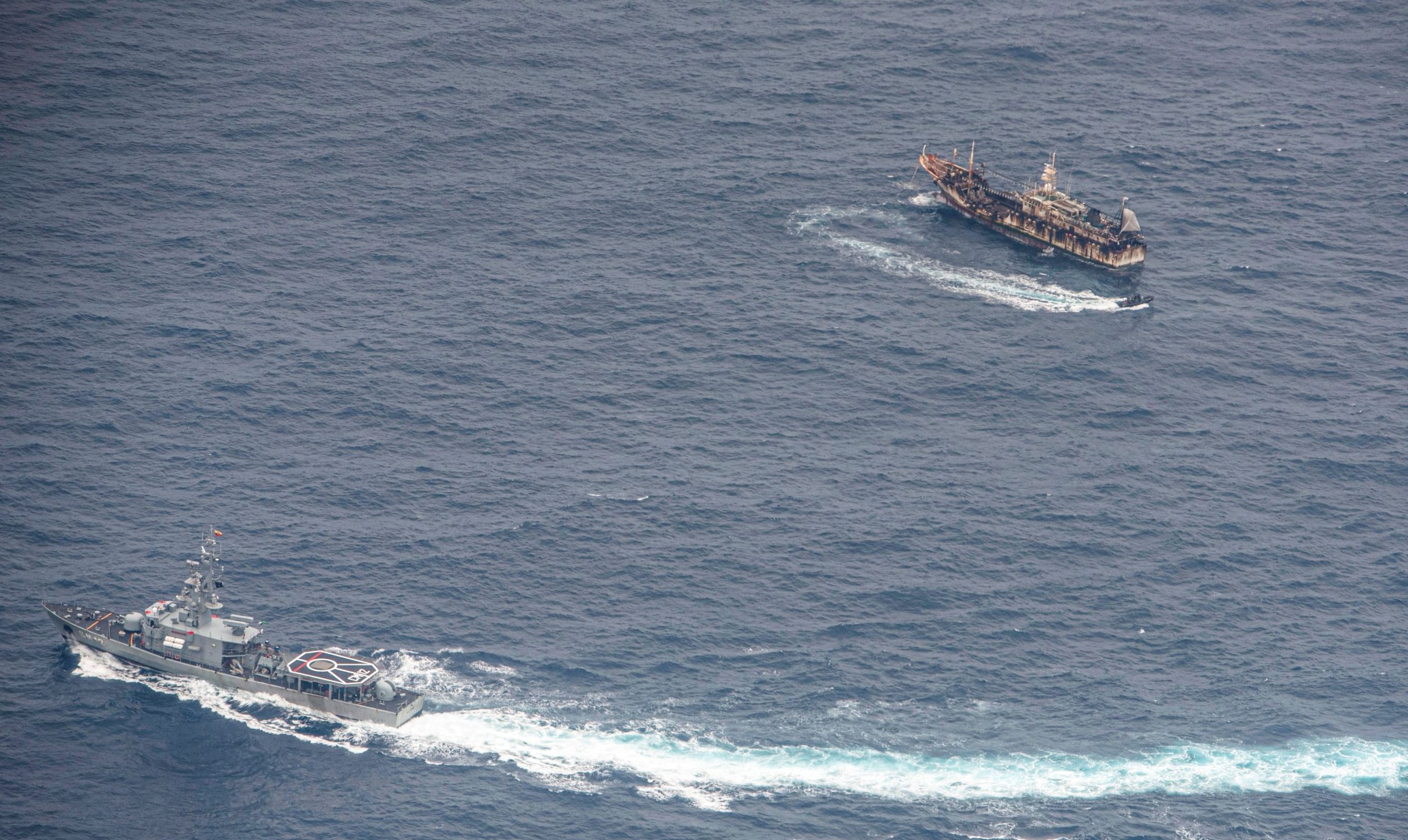
Chinese investment in this strategy is reflected by which provinces these vessels call home. Of the 364 vessels found operating outside the Galapagos in July and August, 92 could not be definitively linked to a specific owner. Of the remaining 272, 188 were from Zhejiang Province. Because Chinese vessel names tend to be uniform and reflect a group owned by the same company but distinguished by different numbers, it is likely that 50 more vessels without company names are also from Zhejiang, because of the similarities in the vessel names. Therefore, two-thirds of the fishing vessels are likely from Zhejiang (238 out of 364). Of the remainder, 46 vessels are from Shandong Province, plus another 19 likely to be from Shandong, for a total of 65, or 18 percent.


Shandong Province, the country’s third largest producer of DWF catch (20 percent in 2018), is home to the second national DWF base, Shaowodao National DWF Base (荣成沙窝岛国家远洋渔业基地), approved for construction in 2016 in the city of Rongcheng. With similar support facilities, Shawodao will have the capacity to dock 1,000 fishing vessels and be able to handle the trade of 600,000 tons of fish, including squid and tuna. Fujian Province, home to China’s first group of DWF vessels and the country’s second largest producer of DWF catch (21 percent in 2018), will be the host province for China’s third national DWF base, Fuzhou (Lianjiang) National DWF Base (福州 (连江) 国家远洋渔业基地) in the city of Fuzhou, which was approved for construction in 2019.
The changing patterns in China’s DWF policies are also reflected in the trade and catch data. Over this time period, China’s imports of squid from Peru and Argentina have fallen, while China’s own catch of squid has risen, possibly because China decided to catch the squid directly through its DWF fleet. According to China’s official statistics, Zhejiang’s catch of squid grew from 69,000 tons in 2009 to 356,000 tons in 2018, while Shandong’s squid catch grew from 21,000 tons to 102,000 tons over the same period.

Visualizing even a portion of the fishing activities in July and August 2020 is instructive on a few fronts. Based on Windward’s algorithmic analysis of AIS data indicating fishing activities, each dot on the image below represents a Chinese vessel engaged in fishing during that two-month window.
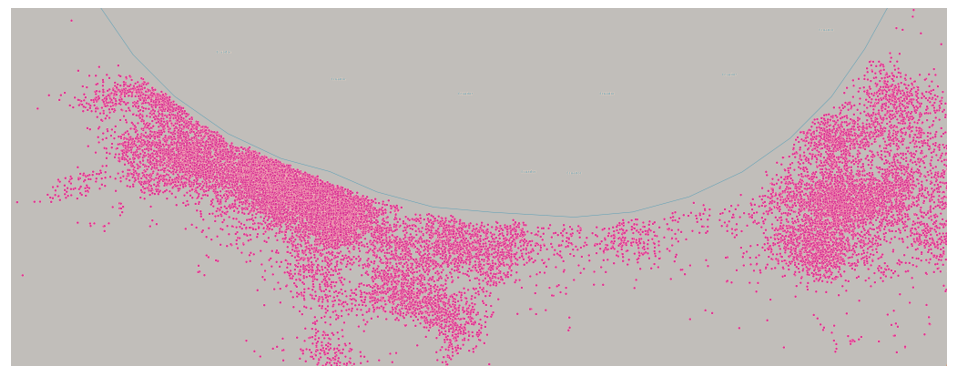
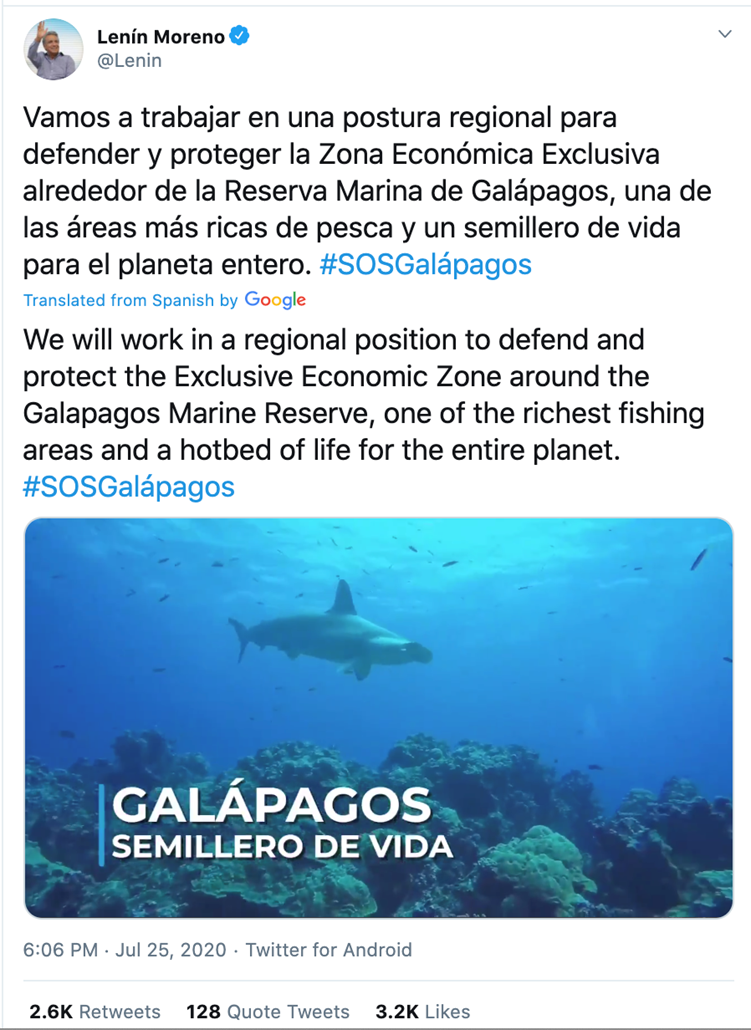
The Chinese fleet is not permitted to fish in Ecuador’s EEZ, and, insofar as the AIS data indicates, the fleet appeared to be only on the high seas, and thus not illegally in Ecuador’s EEZ.
This behavior contrasts with activities in the past. Take, for example, the visualization of fishing activities in July and August 2017, in which fishing Chinese vessels fished within the Galapagos EEZ:
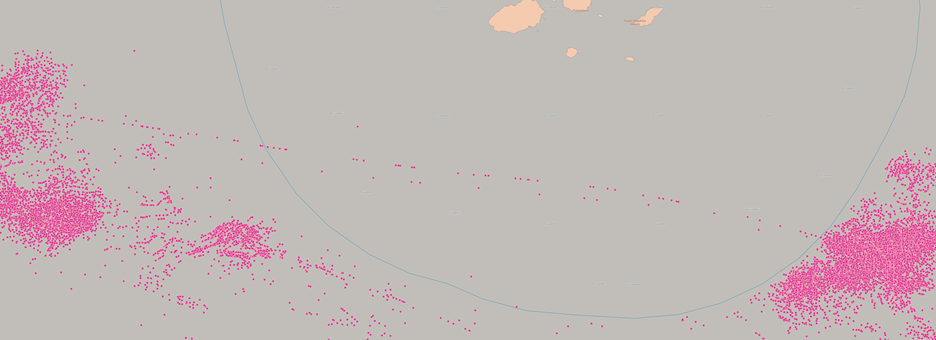
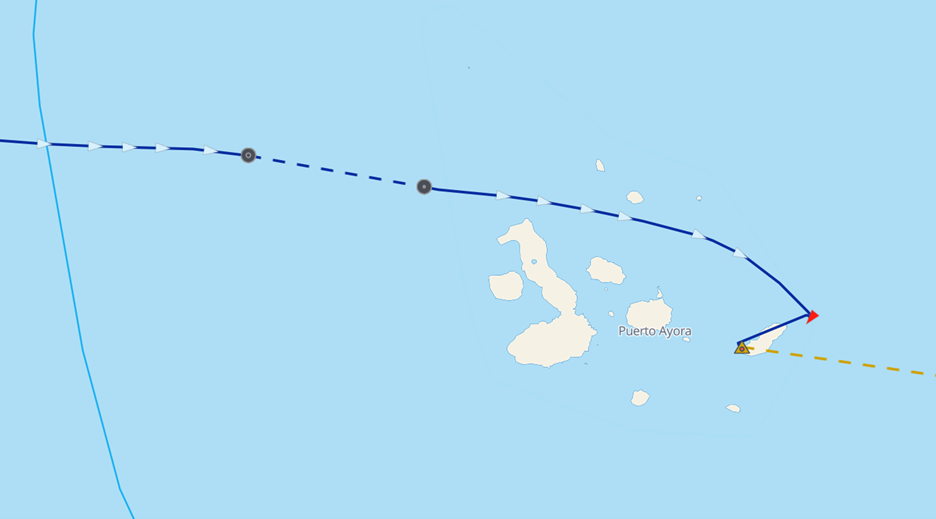
IUU Fishing on the High Seas?
While the fleet does not seem to be illegally fishing in the Galapagos EEZ, the vessels are still subject to various RFMO rules that govern fishing on the high seas. The RFMO that manages tuna in this area is the Inter-American Tropical Tuna Commission (IATTC), of which China is a member. The IATTC sets annual quotas for tuna species, keeps lists of registered fishing and transport vessels, as well as vessels caught engaging in illegal, unreported and unregulated (IUU) fishing. China has 415 longline tuna vessels registered with the IATTC. Of the 364 vessels fishing outside the Galapagos EEZ, only one of them was on the IATTC list of registered vessels.
The vast majority of the rest of the fleet is under management jurisdiction of the South Pacific Regional Fisheries Management Organization (SPRFMO), which regulates high seas species aside from tuna such as jack mackerel and soon, squid. Of the other 363 vessels fishing outside the Galapagos EEZ, all but 16 of them were registered with the SPRFMO. As one of the globe’s newer RFMOs, established in 2012, its species coverage is still growing. China began fishing jack mackerel (竹荚鱼) with 15 vessels in 2003 after conducting exploratory catch missions in 2001 and 2002. China’s catch of jack mackerel grew from 14,000 tons in 2005 to 61,229 tons in 2018, with Shandong Province accounting for 65 percent, followed by Zhejiang Province at 24 percent.
The year 2020 marks the advent of the first large-scale regulation of high seas squid. The SPRFMO issued measures to regulate jumbo flying squid, which will enter into force in 2021. Thus, through the present, China’s squid fishing is not illegal but rather unreported. In the run-up to the entry into force of these measures, China may be establishing as great a fishing presence as possible and taking advantage of this being the last year without regulations. At the same time, also in 2020, the Chinese government initiated the first moratorium on high seas squid fishing, with one area adjacent to the Galapagos. The fact that China has taken this step suggests that China recognizes the current fishing levels by its large fleet are so unsustainable that the fishing effort is undermining the fleet’s own long-term interests.
After all, of the 1,135 vessels registered to the SPRFMO, 700 vessels—62 percent—are flagged to China. The next two largest fleets are 127 and 99 in number, flagged to Panama and Peru, respectively.
The Remaining Challenges
While the Chinese fleet seemed to have avoided illegal fishing in the Galapagos EEZ, and is largely registered with the relevant RFMOs, there are still causes for concern. Vessels can turn their AIS transponders off and go dark. There are some concerns with the flagging of Chinese vessels to other countries, and issues with transshipping catch. Similar vessel names and changing reported vessel measurements increase law enforcement challenges. And finally, even if it is legal, this fishing activity is not necessarily sustainable.
Though the Chinese seemed to stay out of the Galapagos EEZ, what may have occurred is one of three things:
1. The Chinese fleet was being very careful not to break the law and was staying just outside the Galapagos exclusive economic zone.
2. The Chinese fleet was being very careful not to appear to break the law, so was only sending “dark” vessels into the Galapagos exclusive economic zone.
3. The Chinese fleet was being very careful not to appear to break the law, so was using non-Chinese-flagged vessels to provide the catch from within the Galapagos exclusive economic zone and transshipping on the high seas.
By concentrating so many vessels outside the exclusive economic zone, with AIS on, the approach may be to distract from any “dark” incursions into the Galapagos’ waters or to hide the transshipments with other vessels in plain sight. The picture of fishing activities in July and August 2020 when looking at all vessels, not just Chinese vessels, shows that a total 554 vessels—not just 364—engaged in fishing operations, many of them inside the Galapagos exclusive economic zone.

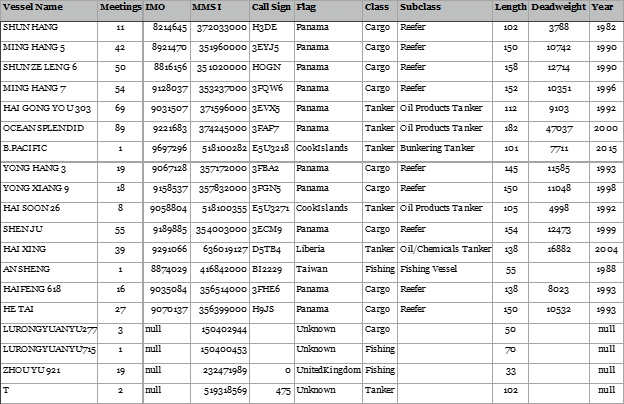
Looking at the behavior of the refrigerated cargo vessels (or “reefers”) on this list, however, shows that the fleet may have learned from the FU YUAN YU LENG 999 experience. The HE TAI, for example is owned by a Chinese company that has the same address as the Chinese company that operates it. That address is in the same area as a number of the companies that own and operate some of the Chinese-flagged vessels that comprise the fleet. But the HE TAI is actually flagged in Panama and has not ever crossed into the Galapagos EEZ. The HE TAI has, however, had rendezvous with 25 of the 364 Chinese vessels that were fishing in the area, two of them twice. While this is not necessarily illegal, reflagging is generally seen as a means to seek lower standards for fishing operations. China has announced new measures regulating transshipment of catch on the high seas, however it is unclear whether these would cover transshipment to vessels flagged to other countries.
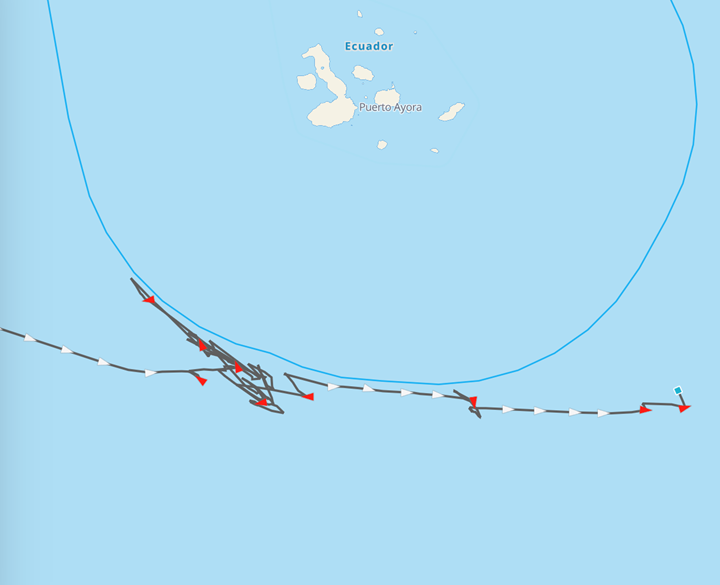
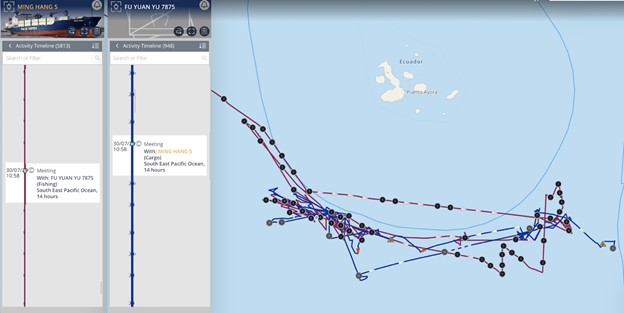
This dynamic is consistent with some of the other reefers. The YONG HANG 3, similar to the MING HANG 5, repeatedly changed its draft between 6.5 and 0.0, making it impossible to determine what effect the 19 meetings it had with the Chinese fleet had on its actual draft. The SHEN JU had been in the area since April and constantly switched its draft between 7.8 and 0.0, similarly making the effect of its 55 meetings with the fleet impossible to determine. The SHUN ZE LENG 6 only became the SHUNG ZE LENG 6 on 29 March 2020 when it changed ownership. Since then, it never called at a port, but did meet 50 times with the Chinese fleet and added a half meter of draft before heading back to China at 83 percent of max capacity by tonnage. The YONG XIANG 9 was in the area since April, without making a port call, and meeting with the fleet 18 times before heading back to China.
All of this points to a systematic and conscious attempt to transship the catch on the high seas to bring it back to China. The obfuscation tactics may be a mix of concern about reputational harm and uncertainty about applicable law.
The Tankers
Of the 20 non-Chinese flagged vessels, six are tankers. One of them is unidentifiable, suggesting it was operating illegally, but it only had two meetings with vessels in the Chinese fleet, both with the same vessel, the LU RONG YUAN YU 939. The B. PACIFIC, which only had one meeting, is the sister vessel to the B. ATLANTIC which is well-known for bunkering in the Gulf of Guinea. Interestingly, though, that one meeting was with the FU YUAN YU 7876, the sister vessel to the 7875 and 7862, both mentioned above. The HAI SOON 26 engaged in eight meetings, but only entered the area at the end of August and left at the beginning of September, suggesting it was possibly just taking advantage of the high concentration of vessels for bunkering. Conversely, the remaining three vessels—the HAI XING (39 meetings), the HAI GONG YOU 303 (69 meetings) and the OCEAN SPLENDID (89 meetings)—all seem to have been in the area specifically to service not only the Chinese fleet but the reefers like the SHUN ZE LENG 6 that seem to be transshipping with the fishing vessels. While such bunkering is not illegal, it is indicative of the extent of this operation as the maintenance of the Chinese fleet at sea requires a variety of service vessels, including tankers.
Twinsies
Another questionable practice is the use of the same name for different vessels because the duplication may serve as an obfuscation tactic to make interdiction more difficult, allowing each vessel to point a finger at the other should anything occur. An interesting example is the United Kingdom-flagged ZHOU YU 921, not to be confused with the Chinese-flagged ZHOU YU 921, which is part of the Chinese fleet. The vessels are not at all physically identical—the British one is 33 meters in length and the Chinese vessel is 51 meters. While the owners of the British ZHOU YU 921 cannot be verified, there is substantial reason to suspect a close relationship to the Chinese-flagged ZHOU YU 921 because 19 meetings occurred between the two vessels in July and August 2020.
In three other cases, vessels had exactly the same name and International Maritime Organization (IMO) number, but were in fact different vessels. Both the CHANG AN 168 and the CHANG TAI 812 had second vessels with the same name and IMO number, though in the latter case, they did have different Mobile Maritime Service Identity (MMSI) numbers. One name, the JIN HAI 779, was used by three different vessels fishing in the area, each of which also used identical IMO and MMSI numbers. Such use of identical names and identifying numbers by multiple vessels is illegal. And two vessels had very similar names, the JIA DE 12 and the JIA DA 12, but only the former was on the SPRFMO list of registered vessels.
Conclusion and Policy Recommendations
This analysis provided an examination of the Chinese fleet around the Galapagos in order to better understand its macro behavior over time, the industry drivers, some of the recent tactics employed by the fleet, and to ascertain whether IUU fishing is occurring. In most cases, what is detectable may not be illegal, and care is clearly being taken by the Chinese fleet to give the appearance of legal compliance with national and international laws. As the recent changes in Chinese policy suggest, some of this compliance is likely to be genuine. China cares about its international reputation, and knowledge in China about marine environmental protection is growing.
At the same time, China’s competing domestic priorities are resulting in what is likely some illegal fishing activity, and definitely unreported and unregulated fishing activity, requiring different policy responses. The evidence suggests that dark vessel activity and multi-national shell games are obscuring illegal fishing inside the Ecuadorian EEZ around the Galapagos. If Ecuador can more closely monitor the activities, not just of the fleet, but the companies that own the fleet, and the vessels that service the fleet, a more complete picture can be drawn.
The fishing activities on the high seas outside the Galapagos EEZ are unregulated, and the total fishing effort seems unsustainable and irresponsible from an environmental standpoint. The fleet likely would not be able to operate without the enormous subsidies the Chinese government provides every year. In 2018, China provided an estimated 21 percent of all global fisheries subsidies, and 27 percent of the harmful global subsidies. The deep pockets of the Chinese government result in a global fishing fleet that exceeds the size of any other fleet in the world.
While this analysis focused on the peak months of July and August 2020 around the Galapagos, the phenomenon has by no means ended—the majority of the vessels have moved south and, as of mid-October, are now concentrated in the high seas outside of the central and southern portions of the Peruvian EEZ.

Development, however, can never be to the detriment of the entire planet, and unsustainable fishing practices around the world have put extreme pressure on global fish stocks and dramatically diminished ocean health. Our ability to sustain human life depends on our ability to maintain the resources needed for our sustenance. As much as this matter is up for legal, political or environmental debate, it is most fundamentally a concern for all humanity.
Tabitha Grace Mallory is Founder and CEO of the consulting firm China Ocean Institute and Affiliate Professor of the University of Washington Henry M. Jackson School of International Studies. Dr. Mallory specializes in Chinese foreign and environmental policy. She conducts research on China and global ocean governance and has published work on China’s fisheries and oceans policy. She previously served as a postdoctoral research fellow in the Princeton–Harvard China and the World Program. Dr. Mallory holds a Ph.D. (with distinction) in international relations from the Johns Hopkins University School of Advanced International Studies (SAIS). She is currently a fellow in the National Committee on U.S.–China Relations Public Intellectuals Program.
Dr. Ian Ralby is a recognized expert in maritime law and security and serves as CEO of I.R. Consilium. He has worked on maritime security issues in more than 80 countries around the world, including in Ecuador and the wider Pacific Coast of South America. He spent four years as Adjunct Professor of Maritime Law and Security at the United States Department of Defense’s Africa Center for Strategic Studies, and three years as a Maritime Crime Expert for the UN Office on Drugs and Crime. I.R. Consilium is a family firm that specializes in maritime and resource security and focuses on problem-solving around the globe.
Featured Image: A fishing boat is seen from an aircraft of the Ecuadorian Navy after a fishing fleet of mostly Chinese-flagged ships was detected in an international corridor that borders the Galapagos Islands’ exclusive economic zone, in the Pacific Ocean, August 7, 2020.(Photo via Reuters/Santiago Arcos)

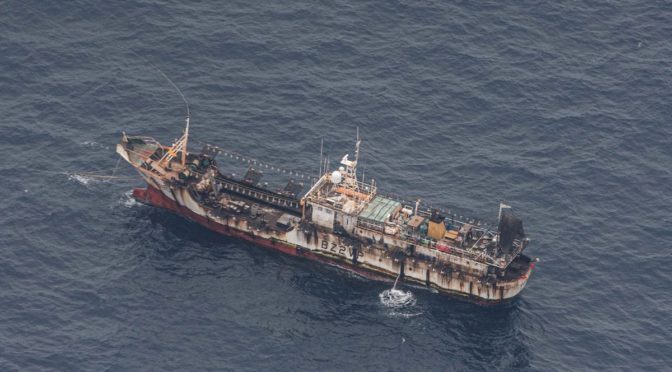
A quite fascinating and informative article, with a quite worrying insight into the illegal tactics used to attempt to cover up IUU fishing activities.
Totally disgraceful and ultimately harmful to fish stocks. A disgrace that China is bankrolling these activities, quite simply in order to hoover up the oceans fish stocks. If this continues, stocks will never recover. The practices of turning off and/or altering data of onboard AIS equipment is also disgraceful, and a danger to other vessels and seafarers, but to the beneficial owners in China they just don’t care as long as the fish and the money keep rolling in. Panama in particular needs to act responsibly over vessel registration, survey, certification and compliance matters, but their track record would indicate they too just don’t care either. Dreadful.